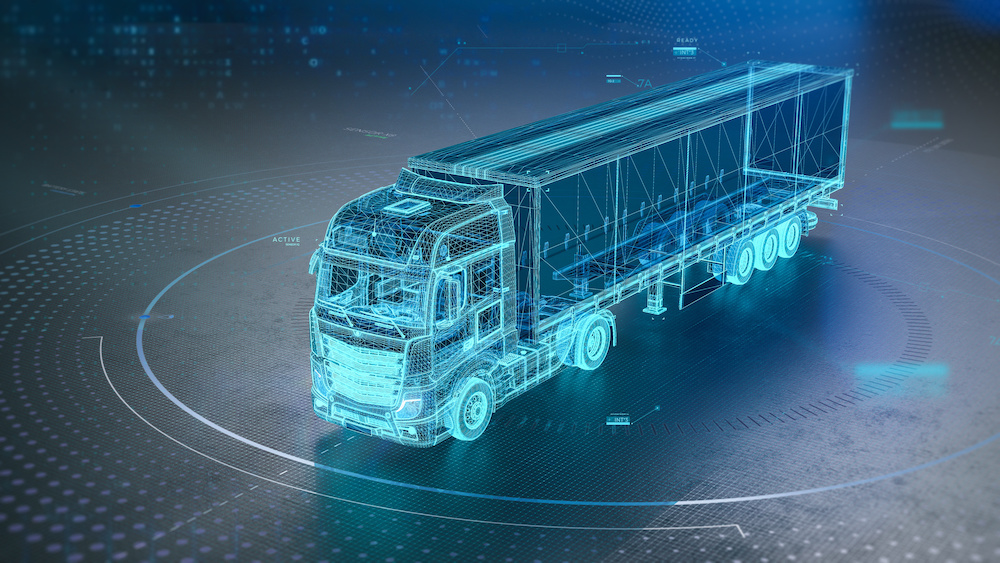Overhyped Or Helpful? Autonomous Vehicles, Drones, and Electric Yard Trucks
Victoria Papadelis
August 15, 2024
9 min read
In recent years, yard management has evolved from an overlooked aspect of logistics to a critical focus area for efficiency and cost savings. The yard—often described as the 'black hole' of supply chain operations—is now under the spotlight, with businesses investing heavily in technology to streamline processes and eliminate bottlenecks. As yard operations become increasingly complex, leveraging the right tools can drive significant improvements in productivity, safety, and sustainability.
However, not all technologies live up to their promises. Investing in overhyped solutions can lead to wasted resources and missed opportunities, while the right innovations can unlock new levels of performance and efficiency. This detailed analysis will help you navigate the landscape of autonomous vehicles, drones, and electric yard trucks, so you can make informed decisions that propel your operations forward.

Autonomous Vehicles
Understanding Autonomous Vehicles in Yard Management
Autonomous vehicles, including self-driving yard trucks, are among the most talked-about innovations in logistics and supply chain management. These vehicles are designed to operate without a human driver, using advanced sensors, machine learning, and AI to navigate, perform tasks, and make decisions in real-time. The goal is to automate repetitive yard tasks such as moving trailers, optimizing the flow of vehicles, and reducing the need for human intervention, which can lead to cost savings, increased safety, and operational efficiency.
In yard management specifically, autonomous vehicles promise to transform operations by handling the intricate movements required between gates, docks, and staging areas. The technology aims to address the ‘black hole’ of the yard, where inefficiencies and delays often go unnoticed and untracked. By automating these movements, autonomous yard trucks could potentially offer a significant upgrade over traditional manual operations.
Key Benefits of Autonomous Yard Vehicles
- Labor Cost Reduction: By eliminating the need for human drivers, companies can reduce labor costs and reallocate human resources to more strategic roles within the operation.
- Increased Safety: Autonomous vehicles can minimize the risks associated with human error, such as accidents due to fatigue, distractions, or miscommunications, thus improving overall safety in the yard.
- Enhanced Efficiency: These vehicles can operate around the clock without breaks, potentially speeding up yard operations and reducing downtime. They can also be programmed to follow the most efficient routes, optimizing the flow of traffic in the yard.
Current Challenges and Limitations
Despite the potential, autonomous yard vehicles face several significant hurdles that limit their current usability:
- Manual Task Dependencies: Many tasks in yard management still require manual intervention, such as pre-cooling refrigerated trailers, opening and closing trailer doors, and connecting glad hands for air brake systems. These tasks are complex and not easily automated, making it difficult for autonomous vehicles to fully replace human drivers at this stage.
- Infrastructure and Technology Requirements: Implementing autonomous yard vehicles requires substantial infrastructure upgrades, including specialized equipment for loading docks, advanced navigation systems, and robust sensors for real-time asset tracking. These investments can be cost-prohibitive for many facilities and require careful planning and integration.
- Safety and Reliability Concerns: Autonomous systems must operate flawlessly to avoid accidents or disruptions. Current technology is still evolving, and issues such as sensor failures, software glitches, or unexpected obstacles can pose risks. Ensuring consistent and safe operation in a busy, ever-changing yard environment remains a significant challenge.
Looking Ahead: The Future Potential of Autonomous Yard Vehicles
The future of autonomous vehicles in yard management is promising, with ongoing advancements aimed at overcoming current limitations:
- Technological Advancements: Innovations are in progress to address the manual task dependencies of autonomous vehicles. Companies are developing automated solutions for tasks like attaching glad hands and opening trailer doors, which could eventually eliminate the need for human intervention in these areas.
- Strategic Integration: For companies interested in exploring autonomous vehicles, starting with a dedicated Yard Management System (YMS) is a practical first step. A YMS can provide the necessary framework for tracking and managing yard activities, making it easier to integrate autonomous vehicles as the technology matures.
Verdict: Overhyped, but with Significant Future Potential
Currently, autonomous yard vehicles are more overhyped than helpful due to their operational limitations, high costs, and the need for substantial infrastructure changes. However, the potential benefits are too significant to ignore. As technology continues to evolve and address the existing challenges, autonomous vehicles could become a game-changer in yard management. Companies that invest in foundational technologies like YMS today will be well-positioned to leverage autonomous vehicles when they are fully ready for practical use.

Drones
The Promise of Drones in Yard Management
Drones have captured the imagination of the logistics and yard management sectors, offering a vision of a fully automated future where aerial vehicles can perform tasks like inventory checks, monitoring, and asset tracking with unprecedented speed and accuracy. Equipped with cameras, sensors, and advanced navigation systems, drones can theoretically replace manual yard checks, providing real-time visibility into the location and status of trailers, containers, and other assets. This technology aims to address the inefficiencies associated with traditional yard checks, which often involve hours of manual labor walking the yard, documenting locations, and updating records.
Challenges and Limitations
Despite their potential, the practical application of drones in yard management faces several significant challenges:
- Weather Dependency: Drones are highly sensitive to weather conditions such as rain, wind, and extreme temperatures. In regions with unpredictable or harsh weather, the reliability and availability of drones for yard operations can be severely compromised, limiting their usefulness.
- Regulatory and Licensing Requirements: Operating drones commercially requires compliance with regulations set by bodies like the Federal Aviation Administration (FAA). Companies must have licensed drone pilots, adhere to strict operational guidelines, and often face restrictions on where and how drones can be flown—especially over people, which is common in busy yards.
- Limited Battery Life and Range: The operational efficiency of drones is constrained by their battery life, which typically allows for only short flights. Frequent recharging or battery swapping is necessary, which can interrupt operations and add to maintenance demands. Additionally, the limited range of drones can be a barrier in larger yard environments.
- Safety and Privacy Concerns: Drones flying overhead pose potential safety risks, particularly in busy yards with constant vehicle and personnel movement. There are also privacy considerations when using drones for monitoring, as they can capture images of individuals and sensitive information.
- High Initial Costs and Maintenance: Investing in drone technology involves not just the cost of the drones themselves, but also the necessary software, training, licensing, and ongoing maintenance. These costs can be prohibitive, especially when considering the alternative technologies available that can achieve similar results.
Verdict: Overhyped
While drones present an attractive, futuristic option for yard management, they are currently more hype than help due to operational, regulatory, and practical challenges. Their sensitivity to weather, limited flight duration, and the complexity of regulatory compliance make them less viable compared to more established and reliable alternatives. However, as technology advances, drones may find more niche applications or become part of a hybrid approach in yards that can justify the investment.

Electric Yard Trucks
The Rise of Electric Yard Trucks in Logistics
Electric yard trucks are gaining traction in the logistics and yard management industries as companies seek more sustainable, efficient, and cost-effective solutions for yard operations. Unlike their diesel or gasoline counterparts, electric yard trucks are powered by batteries, offering a cleaner alternative that aligns with increasing environmental regulations and corporate sustainability goals. These vehicles promise not only to reduce the carbon footprint of yard operations but also to deliver operational efficiencies and cost savings that appeal to forward-thinking organizations.
Key Benefits of Electric Yard Trucks
- Environmental Impact and Sustainability: One of the most significant advantages of electric yard trucks is their ability to reduce greenhouse gas emissions. This reduction helps companies meet stringent environmental regulations and corporate sustainability targets, particularly in states like California, where emissions standards are high and incentives for electric vehicles are robust.
- Lower Operational Costs: Electric yard trucks typically have lower operating costs compared to traditional diesel trucks. This includes savings on fuel, which can be a substantial expense in high-traffic yards, as well as reduced maintenance costs due to fewer moving parts and less frequent servicing requirements. Over time, these cost savings can add up, making electric trucks a financially attractive option.
- Reduced Noise and Improved Work Environment: Electric yard trucks operate much more quietly than their diesel counterparts, leading to a quieter and more pleasant work environment. This can improve working conditions for yard personnel, reduce noise pollution, and potentially increase productivity by reducing the stress associated with loud, continuous engine noise.
- Increased Efficiency and Reliability: Electric vehicles can provide consistent performance without the fluctuations in power delivery typical of internal combustion engines. This reliability ensures that yard trucks are always ready to perform, reducing downtime and improving the overall efficiency of yard operations.
Challenges and Considerations
While electric yard trucks offer many benefits, they also come with certain challenges that companies must consider:
- Charging Infrastructure and Battery Management: Implementing electric yard trucks requires significant investment in charging infrastructure, including high-capacity charging stations that can support the fleet’s needs. Companies must also manage the charging schedules to avoid downtime and ensure that trucks are always available when needed. The development of fast-charging technologies and battery swapping solutions can help mitigate some of these issues, but these systems require planning and capital investment.
- Initial Investment Costs: The upfront cost of electric yard trucks is typically higher than that of traditional diesel trucks. However, the total cost of ownership may be lower over time due to reduced fuel and maintenance expenses. Companies must evaluate the long-term financial benefits versus the initial investment to determine if electric yard trucks are the right fit for their operations.
- Range and Power Limitations: Depending on the size of the yard and the specific operational requirements, the range and power of electric yard trucks can be a concern. For yards with heavy-duty operations or those requiring long distances to be covered frequently, the limited range of current battery technology may pose challenges. However, for most yard operations, the range of modern electric trucks is sufficient, especially when charging opportunities are well-managed.
- Adapting to Operational Changes: Transitioning to electric yard trucks may require changes in operational practices, including training for drivers and maintenance staff on the new technology. Companies need to plan for this transition to ensure a smooth integration of electric vehicles into their existing workflows.
Future Outlook and Technological Advancements
The market for electric yard trucks is rapidly evolving, with continuous advancements in battery technology, charging solutions, and vehicle design. Innovations such as ultra-fast DC charging, battery swapping systems, and improvements in battery energy density are making electric trucks more practical and appealing. Additionally, the increasing availability of government incentives and subsidies for electric vehicles further reduces the financial barriers to adoption.
- Battery Swapping and Fast Charging: Innovative solutions like battery swapping, where a depleted battery is quickly exchanged for a fully charged one, are being explored to reduce downtime and maximize vehicle availability. Fast charging technology is also advancing, with some systems capable of recharging vehicles in a fraction of the time previously required, making electric trucks even more viable for continuous yard operations.
- Integration with Renewable Energy: Some companies are taking sustainability a step further by integrating their electric vehicle charging infrastructure with renewable energy sources, such as solar panels. This approach not only reduces the carbon footprint of their operations even further but also provides cost savings on energy expenses in the long run.
Verdict: Helpful
Electric yard trucks are currently one of the most practical and beneficial technologies for yard management, offering clear advantages in terms of environmental impact, operational cost savings, and improved working conditions. While the initial investment and infrastructure requirements are considerations, the long-term benefits make electric yard trucks a strong option for companies looking to modernize and future-proof their yard operations. As technology continues to advance, these vehicles are likely to become even more efficient, accessible, and integral to the logistics industry.

Embrace the Future of Yard Management Today
The logistics and yard management industries are rapidly evolving, with technologies like autonomous vehicles, drones, and electric yard trucks leading the charge. While these innovations hold immense potential, it's crucial to differentiate between what's genuinely transformative and what's merely hype. Autonomous vehicles and drones, though promising, still face significant challenges that may delay their widespread adoption. On the other hand, electric yard trucks are already proving to be a practical and sustainable choice, delivering clear benefits in cost savings, environmental impact, and operational efficiency.
To stay ahead in this fast-paced industry, taking a strategic approach is key. Implementing a dedicated Yard Management System (YMS) not only streamlines current operations but also sets the foundation for future advancements. By integrating the right technologies at the right time, you can enhance efficiency, reduce costs, and prepare your yard for the next wave of innovation.
Now is the time to take action. Explore how Yard Management Solutions can help you optimize your operations and seamlessly integrate these cutting-edge technologies. Whether you're ready to invest in electric yard trucks or preparing for a more autonomous future, we have the tools and expertise to guide you every step of the way.
Don’t wait—experience the transformation firsthand. Schedule a live demo today to see how our solutions can revolutionize your yard management. With a live demo, you’ll get an in-depth look at how our technology works, how it can be tailored to your specific needs, and the immediate impact it can have on your operations.